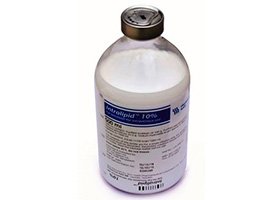
All iLive content is medically reviewed or fact checked to ensure as much factual accuracy as possible.
We have strict sourcing guidelines and only link to reputable media sites, academic research institutions and, whenever possible, medically peer reviewed studies. Note that the numbers in parentheses ([1], [2], etc.) are clickable links to these studies.
If you feel that any of our content is inaccurate, out-of-date, or otherwise questionable, please select it and press Ctrl + Enter.
Intralipid 20%
Medical expert of the article
Last reviewed: 03.07.2025

Intralipid 20% is a parenterally administered nutrient that increases the level of essential and non-essential fatty acids (components of cell walls required for energy metabolism) and energy reserves.
When used in standard doses, it does not cause hemodynamic changes. When the drug is used as prescribed, clinically noticeable changes in pulmonary activity are observed. In some individuals, a transient increase in the activity of intrahepatic enzymes occurs, but this effect is reversible and disappears after the end of parenteral therapy.
ATC classification
Active ingredients
Pharmacological group
Pharmachologic effect
Indications Intralipid 20%
It is used as a parenteral method of nutrition in case of deficiency of essential fatty acids.
Release form
The therapeutic substance is released in the form of a 20% infusion emulsion, in 0.1 and 0.5 l vials; there are 12 vials in a pack.
Pharmacokinetics
The biological parameters of Intralipid 20% are similar to the properties of internal chylomicrons, but unlike them, the drug does not contain cholesterol esters or apolipoproteins, and the phospholipid levels inside it are significantly higher.
During the early phase of catabolism, the drug is excreted in the same way as internal chylomicrons. The components are hydrolyzed and are captured by peripheral and hepatic endings. The excretion rate depends on the composition of fat particles, the intensity of the pathology, the state of the nutritional regime and the rate of infusion. In volunteers, the maximum clearance of the drug when used on an empty stomach was 3.8 ± 1.5 g triglycerides / kg per day.
Lipid oxidation and excretion are determined by the clinical picture of the disease. Increased metabolism is observed after injuries or operations. At the same time, in people with hypertriglyceridemia and renal insufficiency, the metabolic processes of external fat emulsions are quite weak.
Dosing and administration
For an adult, the medication is administered intravenously through a dropper at a maximum rate of 0.5 l/hour. No more than 3 g/kg of triglycerides can be used per day.
For infants and neonates, it is administered intravenously via a drip at a maximum rate of 0.17 g/kg per hour. A premature infant should receive a continuous infusion for 24 hours.
The initial dose is 0.5-1 g/kg per day; it can also be increased to 2 g/kg per day. Subsequent increase in dosage to maximum values (4 g/kg per day) is allowed only with regular monitoring of serum triglyceride levels and liver function tests, as well as oxygen saturation of hemoglobin.
Use Intralipid 20% during pregnancy
There is no information on the development of negative effects when using Intralipid 20% during breastfeeding or pregnancy.
Contraindications
Main contraindications:
- shock state in the acute phase;
- hyperlipidemia;
- pancreatitis in the active phase;
- lipoid nephrosis;
- hemophagocytic syndrome;
- severe liver or kidney failure;
- diabetes mellitus in a decompensated form;
- hypothyroidism (with resulting hypertriglyceridemia);
- intolerance to soy, egg whites, peanuts or other components of the medication.
Side effects Intralipid 20%
Side effects include vomiting, fever, nausea and chills.
Overdose
In case of drug elimination disorder, excessive fat load syndrome may occur, which may cause infection or renal dysfunction. Such syndrome is characterized by fever, hyperlipidemia, disorders in the functioning of various organs, fatty infiltration and coma. In case of severe poisoning with emulsion containing triglycerides, together with the use of carbohydrates, acidosis may develop.
When the administration of Intralipid 20% is discontinued, all of the above symptoms usually disappear.
Interactions with other drugs
Administration of heparin results in a temporary increase in plasma lipolysis values, which results in a temporary decrease in triglyceride clearance (due to depletion of lipoprotein lipase).
Lipase action may also be altered by insulin, although the clinical significance of this effect is rather limited.
K1-vitamin, which is present in soybean oil, is an antagonist of coumarin derivatives, which is why people who use such drugs need to carefully monitor their blood clotting indicators.
Storage conditions
Intralipid 20% should be stored in a place closed to small children and sunlight. The temperature level should not exceed 25°C. Freezing the medicine is prohibited.
Shelf life
Intralipid 20% can be used within a 2-year period from the date of manufacture of the therapeutic element.
Application for children
Lipid elimination in neonates and infants up to 12 months of age should be monitored regularly. Lipid excretion is assessed by measuring serum triglyceride levels.
Analogues
The analogs of the drug are the substances Vamin 14, Dipeptiven, Aminoven infant with Vaminolact, and in addition Infezol, Aminosteril n-hepa and Hepavil.
Manufacturer
Attention!
To simplify the perception of information, this instruction for use of the drug "Intralipid 20%" translated and presented in a special form on the basis of the official instructions for medical use of the drug. Before use read the annotation that came directly to medicines.
Description provided for informational purposes and is not a guide to self-healing. The need for this drug, the purpose of the treatment regimen, methods and dose of the drug is determined solely by the attending physician. Self-medication is dangerous for your health.

